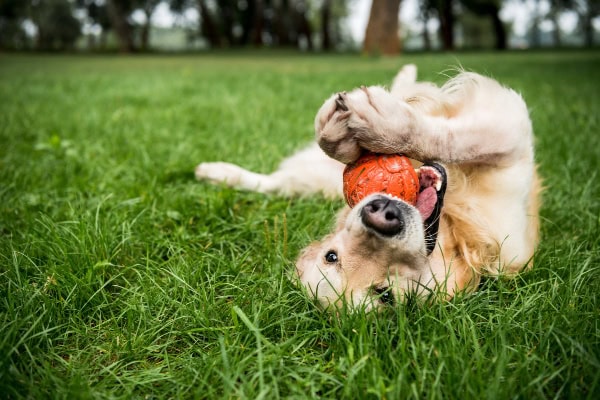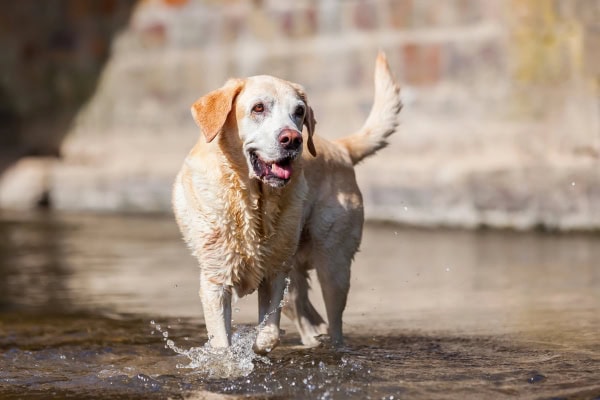Enrichment for senior dogs isn’t just a way to keep your senior dog happy. It is good for his or her brain health too! Discover how physical activity and mental stimulation for senior dogs can help delay the onset of cognitive dysfunction. Integrative veterinarian Dr. Julie Buzby explains.

As our beloved canine companions age, they may experience cognitive decline, just like humans. In fact, 28% of 11-12 year old dogs, 48% of 14 year old dogs, and 68% of 16 year old dogs will show at least one marker of canine cognitive dysfunction (i.e. doggy dementia).
This cognitive decline can manifest as disorientation, changes in social interactions, altered sleep-wake cycles, and other behavioral changes. Understandably, such changes can have a negative impact on the quality of life of our dear senior dogs.
But the good news is that researchers are learning how to fight the effects of canine aging. And they’ve made an important connection between exercise and mental enrichment as a way to reduce the risk of doggy dementia.
By the end of this article, you’ll have more tools in your toolbox to help your senior dog enjoy a happy life. Plus, you’ll learn the relationship between physical activity and cognitive dysfunction.
Research demonstrates a connection between physical activity and cognitive function
First things first. Let’s get to the science behind why exercise and mental stimulation are so critical for protecting the health of our senior dogs’ brains.
One of the organizations that is working hard toward the goal of helping our dogs live longer and stay healthier is the Dog Aging Project. In September of 2022, the Dog Aging Project published a study titled “Associations between physical activity and cognitive dysfunction in older companion dogs: results from the Dog Aging Project“.
As part of the study, researchers asked dog parents to fill out two questionaries. One, called the Health and Life Experience Survey (HLES), collected data about the dog’s demographics, environment, behavior, physical activity, diet, health status, and medications, supplements, and preventives.
The second, the Canine Social and Learned Behavior Survey (CSLB), took a look at the dog’s cognitive health with the intent of identifying behaviors that indicate canine cognitive dysfunction. (The CSLB is a modified and validated form of the Canine Cognitive Dysfunction Rating Scale (CCDR), a well-accepted CCD scale for dogs.)

This amazing study involved over 10,000 dogs, aged 6 to 18 years. By evaluating a large and diverse population of dogs, researchers hoped to identify modifiable risk factors that may prevent cognitive dysfunction and dementia in our canine friends. And they did!
Key Finding: Physical activity is associated with better cognitive outcomes.
The study revealed several significant findings regarding the relationship between physical activity and cognitive dysfunction in older dogs. Across all measures of cognitive dysfunction, researchers found a robust negative association between physical activity and cognitive decline.
In other words, the study found that higher levels of physical activity were associated with better cognitive outcomes in dogs.
The improvement in cognitive function included:
- Lower scores on the cognitive dysfunction rating instrument (fewer signs of dementia in dogs)
- Decreased risk of dementia
- Less owner-reported cognitive decline over the preceding 6 months
Even after controlling for factors such as age, sex, weight, and owner age, this association held true.
That being said, the study noted it is possible that dementia itself could lead to a lack of exercise. Thus, it is important to understand that the study results, which are based on observations by owners, suggest a correlation, not causation. What this means is that there is a positive connection between physical activity and cognitive health. But it can’t be said at this point that increased physical activity causes a reduction in the risk of cognitive impairment.
Key finding: Multiple other factors also influence cognitive health
Additionally, the study identified several other factors that were associated with cognitive health in dogs:
- Sensory impairment—Dogs with sensory deficits (e.g. vision loss or hearing loss in dogs) were more likely to exhibit cognitive decline.
- Training history—Dogs with an extensive training history were less likely to exhibit signs of cognitive decline.
- Diet and supplementation—Dogs that received daily neuroprotective supplements (e.g. omega-3 fatty acids for dogs) had better cognitive outcomes.
- Health conditions—Dogs with certain conditions (e.g. neurological conditions, orthopedic impairments, dental disease in dogs, cancer, kidney disease in dogs) were more likely to experience cognitive dysfunction.
6 Senior dog enrichment activities
The biggest takeaway from this study is that ensuring your senior dog gets regular physical activity and mental stimulation can help support cognitive health. So how exactly do you do that? Well, here are six of my favorite ways to keep your senior dog engaged and active:
1. Go for regular walks
When possible, aim for at least 30 minutes of moderate-intensity exercise. This could include brisk walks or gentle jogs.

However, especially when starting an exercise program, it is important to keep your dog’s physical limitations and fitness level in mind. If your dog is not used to much physical activity, it is critical that you start slowly. Then you can gradually work up to more exercise. Otherwise, you could risk your dog getting hurt.
Additionally, if your dog is suffering from osteoarthritis in dogs, has an old torn ACL in dogs, or is struggling with other mobility-limiting conditions, it is best to talk to your veterinarian before starting an exercise program. Sometimes there are ways to keep your dog safe and comfortable with this level and duration of activity. But in other cases, you may need to make modifications.
2. Play interactive games
Games like fetch, tug-of-war, object sorting, and hide-and-seek can provide both physical and mental stimulation. They let your dog move around and use his or her brain. Plus, doing an activity with your dog is a great way to strengthen your bond.
It may take some trial and error to figure out what your dog likes best. So don’t give up if he or she isn’t that interested in the first game you try. Also, as discussed previously, keep your dog’s physical status in mind. A dog with dental disease may not want to play tug-of-war. Or a dog with arthritis might prefer hide-and-seek to fetch.
3. Provide puzzle toys
Toys that require your dog to solve a puzzle or engage in problem-solving can help to keep his or her mind sharp. There are so many options for mental stimulation toys for dogs such as puzzle games, treat-dispensing toys, slow feeders, and more. Plus, you can try out DIY options such as scatter feeding or ice blocks with treats in them.
If your dog has never used a puzzle toy before, it may take him or her a bit of time to build confidence. Start with something easy and show your dog how to get to the tasty treats. Then, as your dog becomes a puzzle pro, you can move on to more complex toys.
4. Practice obedience training
Regular training sessions can help keep your dog’s mind engaged and reinforce his or her learning abilities. Simply put, the old adage, “You can’t teach an old dog new tricks” isn’t true.
Senior dogs are still quite capable of learning, and many really enjoy it. They may not be jumping through hoops if they are arthritic. But in their senior years, dogs can certainly learn new tricks. You can teach them how to shake hands, pick up objects, turn on light switches, speak, and so much more. Plus, reviewing old tricks and commands also helps keep your dog’s mind active.
In preparation for potential age-related hearing loss, you may also want to consider teaching your loyal companion hand signals for dogs. Learning them while your dog can still hear tends to be easier than after he or she is deaf. And still being able to communicate well with your deaf dog is huge for your bond.
5. Introduce new experiences
Exposing your dog to new environments, smells, and experiences can help to stimulate his or her senses and maintain cognitive function.
It is easy to get into the rut of taking the same path for your daily walks. But why not take a new route to add variety to your dog’s life? Or you could take your dog to a new neighborhood, park, or beach for a change of scenery.
If the weather isn’t too warm or cold and dog car sickness isn’t a concern, your dog might also enjoy taking a car ride with you. However, please don’t leave your senior pup unattended in the car. Trips where your dog can get out of the car with you or you don’t need to get out of the car tend to be safest.
For some dogs, spending time with canine friends can also be mentally stimulating. But watch your dog carefully to ensure he or she is not getting stressed or too worn out. This is especially important if your dog is playing with younger dogs, who usually have more energy and stamina.
6. Let your dog use his or her nose
Getting a chance to do some sniffing can help keep your dog’s brain engaged and happy. Dogs love to use their noses. And one of my vet school professors told us that 10-20 minutes of sniffing a day can provide more mental stimulation than anything else. This has always stuck with me.

There are several ways to provide your dog with the chance to use his or her sense of smell. The simplest is to take your dog on a “sniffari.” This is a walk or excursion that has one goal—to allow your dog to sniff anything he or she wants (as long as it is safe, of course) for as long as he or she wants. It might be a bit boring for you. But your dog will probably love getting to follow his or her nose and revel in the new scents.
If your dog isn’t able to walk, you can also carry your dog outside and place him or her on a blanket to enjoy the scents. Or you could use a dog wagon or stroller to take your dog from place to place.
Additionally, some people will hide treats or scented items in a snuffle mat to provide some nose exercise. Or they might start doing official scent work with their dog. All of these are great ways to let your dog use his or her nose and brain.
Work with your veterinarian and listen to your dog
The connection between your dog remaining mentally and physically active and improved cognitive function is so compelling. It is amazing to think that something as simple as exercise and other forms of enrichment can potentially protect your dog’s brain from decline. With this in mind, I would urge you to start implementing some of the six senior dog enrichment activities discussed above.
However, before you do, please check in with your vet and your dog. The last thing I would want you to do is dive into an exercise and enrichment program too quickly and have your dog become sore or injured. Your vet can give you a good idea of what is appropriate for your dog.
And your dog will let you know how he or she is feeling about the activities you try. If your dog doesn’t seem interested or is struggling physically, try something else. There isn’t a one-size-fits-all approach to senior dog enrichment. Instead, the best plan is to find out what works well for you and your dog. Together, you can strengthen your bond and protect your dog’s cognitive function during his or her golden years. It’s a win-win situation!
What is your favorite enrichment for senior dogs?
Please comment below.


I have found over the years that it’s been helpful to teach my dogs skills and games when they’re younger (e.g. pushing a ball, multi-layered tricks, games) so that as they’ve grown older they have a good foundation of skills to work from for mental stimulation. These can be modified based on cognitive function (made more complicated when my dogs were sharp, or less so with cognitive decline). Scent games such as looking for treats or a favorite toy, are a wonderful way to engage senior dogs, even those with dementia. In her last months, my senior collie had dementia, was almost blind and deaf, and had arthritis, but she was able to learn how to search for a toy with cookies placed on it, and “find it!” quickly became her favorite game.
Hi Kerry,
Yes! I love that you can change the games to fit your dog’s current abilities. Thank you for offering these great tips for other readers to use at home with their dogs. Best wishes to you and yours!
walks 3x a day off leash for a total of at least 2 hours a day with free sniffing, of course. Lots of pats and hugs and reminders of how great he is. Allowing him to come on all horseback rides at a slow pace (horse walking) Cooked diet of things he really likes. Interaction with other dogs.
Hi Claudia,
This sounds amazing! Best wishes to you and your sweet boy. Keep up the good work!
Our dogs love a dish towel roll up! We just lay a dish towel out, put tiny treat pieces all over it, and then fold it up and roll it up in different ways- and then put it on the floor for them to figure out.
Hi Jill,
What a great and easy way to provide mental stimulation! Thanks for sharing!
I love this post! Dexter will be 15 next month and is doing pretty darn good. Even though he has had a neurological condition all his life, we still enjoy positive training, sniffy walks, stroller adventures, dog-friendly travel, parks, indoor stores etc. He has the start of some doggy dementia, but I feel his on-going enrichment has kept this to a minimum. Thank you so much for sharing this! ~Tonya & Dexter
Hi Tonya,
I am so glad Dexter is enjoying all these wonderful activities. He is a lucky boy to have you taking such good care of him. Thanks for sharing your experience with us. Best wishes to you both!